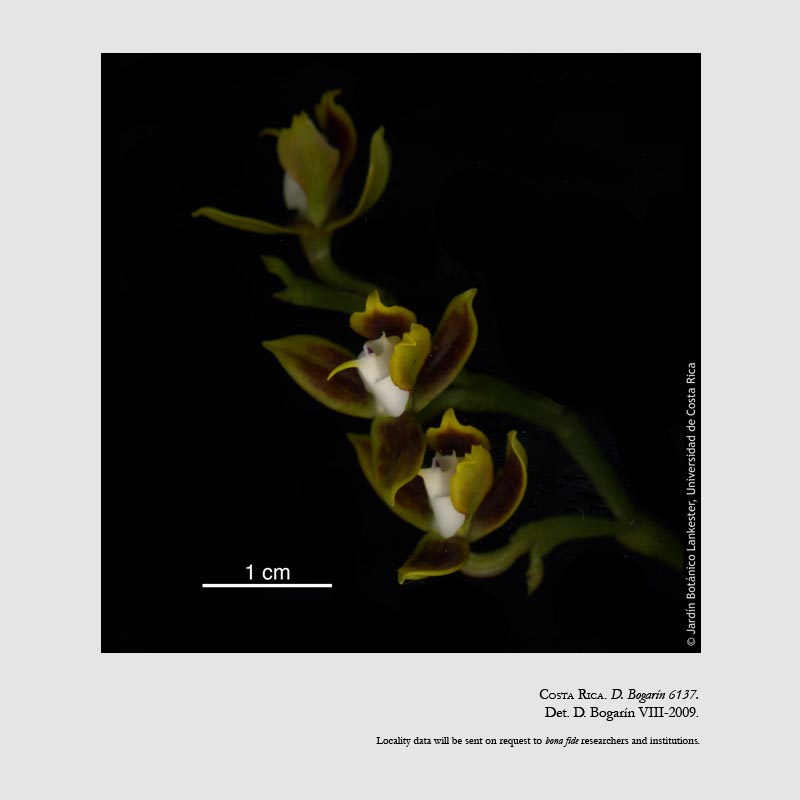

Epidendrum epidendroides (Garay) Mora-Ret. & García Castro 1990 publ. 1991 GROUP Neowilliamsia
Photo by © Bogarin and The Epidendrum Website
TYPE Drawing by © Jimenez, Hágsater & E.Santiago and The AMO Herbario Website


 LATE
LATE  THROUGH EARLY
THROUGH EARLY
Common Name The Epidendrum-Like Epidendrum [refers to this species similarity to an Epidendrum, as it was originally described in the genus Neowilliamsia]
Flower Size 1.2" [3 cm]
Found in Costa Rica in wet montane forests at elevations around 900 to 1700 meters as a to small to medium sized, warm to cool growing epiphyte with an erect, simple, cane-like, branching from the basal to intermediate internode of the previous stem, basally terete, ancipitous above, thin stem enveloped basally by tubular, somewhat inflated towards the apex sheaths and carrying 2 to 5, all along the apical half of the stem, subcoriaceous, alternate, oblong-elliptic, obtuse, minutely apiculate, margin entire, articulate below into the base leaves that blooms in the late spring through early fall on a terminal, occuring only once, racemose to paniculate, erect, ancipitose, zig-zag, two winged, 3.4 to 6.8" [8.5 to 17 cm] long, lax, few flowered inflorescence with a towards the middle, triangular, narrow, acuminate, conduplicate, anciptose, prominent bract and 1/3 or less as long as the ovary, deltoid, acute, conduplicate, ancipitose floral bracts and carrying 7 to 18, simultaneously opening, fleshy, resupinate flowers.
The branching stems have leaves all along the upper third of the stem and the inflorescence is zigzag with the flowers arising from the 2 edges, the tridentate apically petals, the median lobe of the lip is rectangular with a filiform apex and a strongly incurved ovary distinguish this species.
"Epidendrum epidendroides belongs to the GROUP Neowilliamsia characterized by the ancipitose stems and rachis with conduplicate, acute bracts, distichous, non-resupinate flowers lip often digitate and with 2 or 4 pollina with 2 hard, laminar, caudides. The species is recognized by the racemose to paniculate inflorescence, zigzag rachis, apically tridentate petals and peculiar lip with the lateral lobes basal to the column, and midlobe half united to the column, calli at the middle, and apical half triangular, acuminate and revolute; ovary triquetrous. The majority of the species of this group have a terete ovary, except for E. epidendroides and E. tenuisulcatum (Dressler) Hágsater, which has an 10 to 20 " [25 to 50 cm] long, paniculate inflorescence, acute petals and midlobe of the lip triangular, same size and shape of the lateral lobes. Epidendrum bicuniculatum Hagsater & E.Santiago has a similar but racemose inflorescence, sepals .4" [10 mm] long, flowers white tinged with magenta, petals spatulate, rounded, lip subentire, widely obovate, with a very small narrowly triangular midlobe, callus formed by 5 subdigitiform lobes, column with apical, erect tooth and nectary with an additional short cuniculate cavity that does not penetrate the ovary. NOTE: In nearly all species of Epidendrum the lip expands from the apex of the column, or from where the union of the column and the claw of the lip end. However in this species, as well as in Epidendrum bicuniculatum Hagsater & E.Santiago the lip starts spreading from the base of column, the union of the column to the lip extends well beyond, to about the middle of the lip or beyond. In E. tenuisulcatum (Dressler) Hágsater the lip expands from middle of column." Hagsater etal 2007
Synonyms *Neowilliamsia epidendroides Garay 1977
References W3 Tropicos, Kew Monocot list , IPNI ; Orquídea (Mexico City). 8(1): 3 1981 as Neowilliamsia epidendroides; Field Guide to the Orchids of Costa Rica and Panama Dressler 1993; Rudolf Schlechter Die Orchideen Band 1C lieferung 42 - 43 pg 2626 - 2762 Brieger 2001 as Neowilliamsia epidendroides drawing fide; Manual de las Plantas de Costa Rica Vol 3 Hammel, Grayum, Herrera and Zamora 2003 photo fide; Icones Orchidacearum Vol 9 Plate 912 Hagsater & Sanchez 2007 see recognition section; Icones Orchidaceaum 9 Plate 932 Hagsater & Salazar 2007 drawing fide; Icones Orchidacearum 9 Plate 995 Hagsater 2007 see recognition section;
--------------------------------------------------------------------------------------------------------------------------